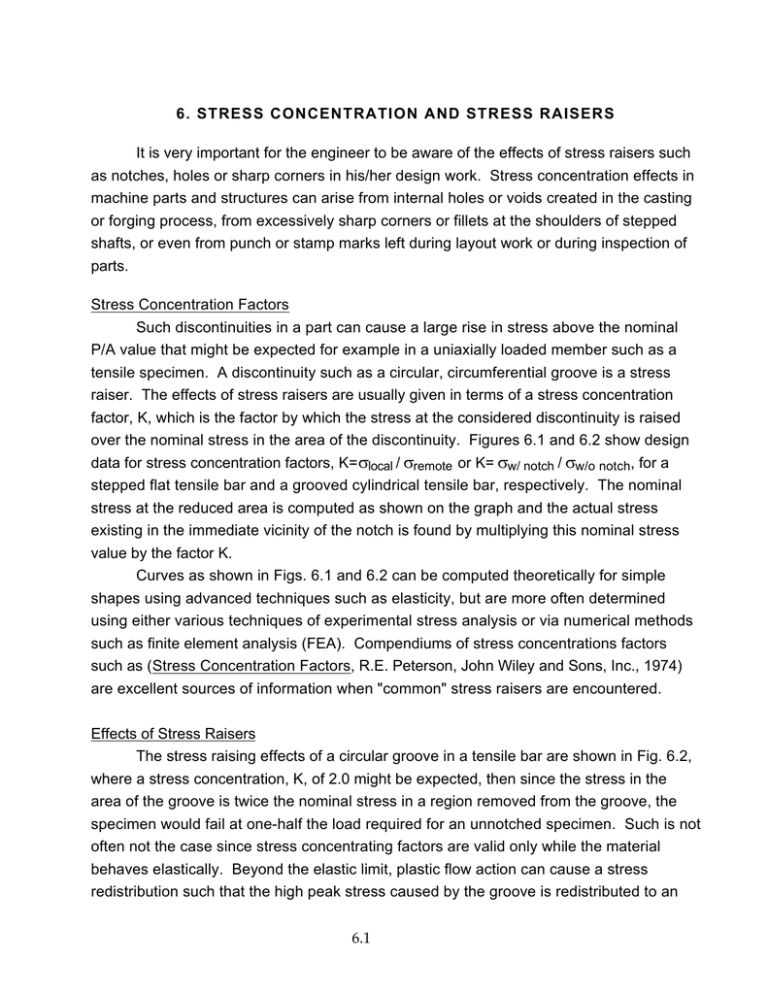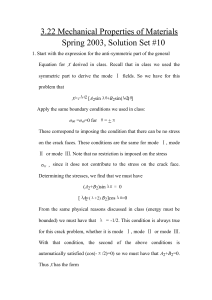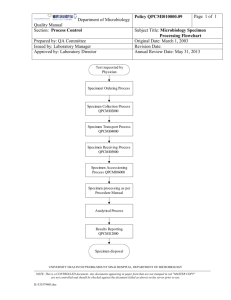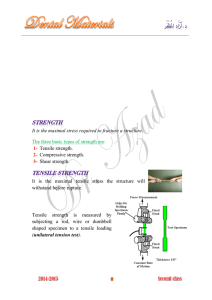6. STRESS CONCENTRATION AND STRESS RAISERS
advertisement

6. STRESS CONCENTRATION AND STRESS RAISERS It is very important for the engineer to be aware of the effects of stress raisers such as notches, holes or sharp corners in his/her design work. Stress concentration effects in machine parts and structures can arise from internal holes or voids created in the casting or forging process, from excessively sharp corners or fillets at the shoulders of stepped shafts, or even from punch or stamp marks left during layout work or during inspection of parts. Stress Concentration Factors Such discontinuities in a part can cause a large rise in stress above the nominal P/A value that might be expected for example in a uniaxially loaded member such as a tensile specimen. A discontinuity such as a circular, circumferential groove is a stress raiser. The effects of stress raisers are usually given in terms of a stress concentration factor, K, which is the factor by which the stress at the considered discontinuity is raised over the nominal stress in the area of the discontinuity. Figures 6.1 and 6.2 show design data for stress concentration factors, K= σlocal / σremote or K= σw/ notch / σw/o notch, for a stepped flat tensile bar and a grooved cylindrical tensile bar, respectively. The nominal stress at the reduced area is computed as shown on the graph and the actual stress existing in the immediate vicinity of the notch is found by multiplying this nominal stress value by the factor K. Curves as shown in Figs. 6.1 and 6.2 can be computed theoretically for simple shapes using advanced techniques such as elasticity, but are more often determined using either various techniques of experimental stress analysis or via numerical methods such as finite element analysis (FEA). Compendiums of stress concentrations factors such as (Stress Concentration Factors, R.E. Peterson, John Wiley and Sons, Inc., 1974) are excellent sources of information when "common" stress raisers are encountered. Effects of Stress Raisers The stress raising effects of a circular groove in a tensile bar are shown in Fig. 6.2, where a stress concentration, K, of 2.0 might be expected, then since the stress in the area of the groove is twice the nominal stress in a region removed from the groove, the specimen would fail at one-half the load required for an unnotched specimen. Such is not often not the case since stress concentrating factors are valid only while the material behaves elastically. Beyond the elastic limit, plastic flow action can cause a stress redistribution such that the high peak stress caused by the groove is redistributed to an 6.1 almost uniform stress across the cross section, as if the groove didn't exist at all. This plastic flow action is the reason why notches and holes in ductile materials may not lower the ultimate strength when the specimen is tested statically, and is why stress concentrations are sometimes ignored when designing with ductile materials. If the groove is sufficiently deep, the large amount of material adjacent to the groove may prevent any plastic flow action from occurring, and the specimen will fail at a stress higher than an ungrooved specimen, stress being based on the reduced section area as shown in Fig. 6.2. This is an instance when a stress concentration can be dangerous in a ductile material. Very little of the energy-absorbing plastic flow will occur with such a severe notch, and such a member may fail in a brittle manner with a small shock load. In addition it should be remembered that any grooves at all are dangerous in ductile materials if the load fluctuates in magnitude, since fatigue crack initiation is a surface phenomenon and the resulting fatigue strength is strongly influenced by surface finish. The effects of a discontinuity in a brittle material are very much different than in a ductile material. With these materials, no stress relieving plastic flow action is possible and the full value of the stress concentration is valid right up to the fracture strength. For these materials, then, we expect the fracture strength to be reduced from the unnotched fracture strength by the value of K. In fact, one method for determining K is to use brittle plaster test specimens with notches of various severity. Design with brittle materials must be done with a great deal of care to avoid undesirable failures. Generous fillets are used, holes eliminated, and attachments carefully worked out. Considerable care must be taken to avoid even surface scratches during fabrication. Experimental Techniques Elastomer Models: Geometric models can be used when the concern is with the elastic behavior of materials. Metal specimens are not particularly good for demonstrating elastic behavior and stress concentration effects because they are so stiff. It is much easier to visualize elastic behavior if an elastomer specimen is used. There is, however, one important difference between the behavior of most elastomers, such as rubber, and that of metal. The stress-strain relation is linear, elastic (to yielding) for metal and is nonlinear, elastic for rubber. This difference is offset by the large, easily measured strains, which occur in rubber. Usually a square grid of lines is printed on the surface of the specimen. A loading frame can be used on which the specimen is stretched to approximately twice its original length. The shape of the grid network is then carefully observed while the specimen is in 6.2 the frame. At the junction of large and small portions of the specimen, it can be observed that the strains are significantly greater than those removed from the junction. In fact, the exact region of maximum strain can be seen on the deformed grid and the stress (strain) concentration factor can be calculated. Brittle Coating: One of the most straight-forward methods of experimental stress analysis involves the use of a brittle coating. During testing, brittle materials fracture with a clean, square break that is always oriented so the fracture surface is normal to the direction of the largest principal stress. The brittle coating technique utilizes this property to gage the magnitude and direction of stresses in a loaded member. The use of brittle coatings in stress analysis has a long history, but its real beginning was in the observation that hot-rolled steel with a mill-scale coating would behave in a most unusual manner when stressed. In tension tests, for example, the mill scale would crack in a geometric pattern indicating principal stress direction. In a tensile test the cracks appear normal to the direction of load, while in a torsion test the cracks appear in a 45° helix pattern. Figure 6.1 Stress concentration factors for a stepped, flat tensile specimen. 6.3 Figure 6.2 Stress concentration factors for a circumferential grove in a tensile specimen. The usefulness of the brittle oxide mill scale is limited by the fact that the yield point of the material must be exceeded before cracking occurs. Today a much more sensitive brittle coating known as Stresscoat™ is available. This material is a patented mixture which can be sprayed on the structure to be analyzed and after drying will crack at strain levels as low as 400 µ m/m. Stresscoat™ possesses many of the important characteristics of a brittle material, however, it also has several limitations which must be allowed for during usage. One of these is that the Stresscoat™ must dry for several hours after application before it can be used. In addition, although Stresscoat™ is now available in aerosol cans, the grade to be used depends on the temperature of the test room only. The material is simply sprayed on to an average film thickness of about 0.01 mm or, with practice, until the correct uniform yellow shade is obtained. At the same time the model is sprayed a number of calibration specimens are also sprayed and all are allowed to dry in the test environment. At the time of testing the Stresscoat™ is first "calibrated" by loading the calibration specimens as a cantilever beams in a special loading fixture. A series of fine cracks normal to the long axis of the beam will be evident and the last crack nearest the loading 6.4 cam is marked with a soft pencil; the strain level at this crack, as indicated when the bar is held in a fixture, is the material sensitivity. This is true because the strain level in a cantilever beam is a maximum at the rigid end and decreases uniformly to zero at the loaded end. Somewhere, then, along the length of the bar the strain will decrease to a level that is insufficient to crack the coating. The last crack appearing nearest the loading end is the critical level of strain. A typical Stresscoat™ test is as follows: An estimate of the maximum load to be applied is made and load increments to reach this load decided upon. Because the Stresscoat™ is sensitive to the duration of load application, a loading interval is used. The specimen is loaded to the level of the first interval, inspected for cracks and then unloaded within the time interval allotted. The specimen is then allowed to remain unloaded for about five min before loading to a load increased by the desired increment. Each loading inspection and unloading cycle must be done within the same time interval, probably 100 s per interval is reasonable. As the crack pattern progresses with increasing loads, the locus of points of crack tips is marked with a grease pencil. These marked lines are points of known strain value as found from the calibration bar. The most critical cracks in this experiment are the initial cracks that form at the reduced section. These will be the first cracks that form and considerable care should be exercised in obtaining the load at which they initiate. The calibration bars are loaded in one-second intervals, and the sensitivity thus obtained is corrected to the actual sensitivity caused by the longer loading cycle in the model by using a creep correction chart supplied by the instructor. Photoelastic Technique: The photoelastic technique is one of the most powerful of experimental stress analysis techniques. The photoelastic technique is valuable because it gives an overall picture of the stress field, quickly showing regions of stress intensification. In addition, the direction of principal stresses is also easily determined. Like all experimental techniques, photoelasticity requires some practice to yield accurate results, in particular, the determination of the principal stresses σ 1 and σ 2 on the interior of the model requires considerable effort. Often, one is interested only in determining the stress on the boundary of the model where one of the principal stresses is zero. In the photoelastic method a model of the shape to be investigated is made from a suitable transparent material. The model is then loaded in a manner similar to the actual part and an accurate description of the stress magnitude and direction is obtained by measuring the change in optical properties of the transparent model. These changes in properties are measured by viewing the model in a special equipment called a polariscope, so named because polarized light or light vibrating in a single plane only, is used. 6.5 The property of the model material that makes it suitable for stress field studies is termed birefringence. The effects of this property are as follows: 1. A polarized light beam passing through a birefringent material becomes split into two components, parallel to each direction of the principal stress axes. 2. These split polarized beams are out of phase by an amount that is dependent of the difference of the principal stresses, i. e. to (σ 1 −σ 2 ) at a point on the loaded model. The theoretical background of photoelasticity is beyond the scope of these laboratory notes, although numerous references are also available on this experimental technique. Simply note how the engineer can quickly use photoelasticity to determine stress concentrations Typically, the polariscope is used in what is termed a circularily polarized light configuration. In this configuration the model is located between the polarizing elements as sketched in Fig. 6.3. Note in the Fig. 6.3 that special filters called polarizers are used, one at each end of the polariscope. Inside these filters is another set of polarizing filters called quarter-wave, (λ 4) , plates. These elements can be arranged so the background light is either light, called light field, or completely extinguished, called dark field. Figure 6.3 Circular polariscope 6.6 When the loaded model is viewed in this type polariscope, a fringe pattern termed an isochromatic pattern is apparent. These patterns are the loci of constant principal stress difference. That is, if we know the calibration constant f of the photoelastic material then t f = (σ1 − σ 2 ) (6.1) N where f is the stress-optical coefficient, N is the fringe order, t is the model thickness, and σ 1 and σ 2 are the plane-stress principal stresses. Each dark band (See Fig. 6.4) for a dark field arrangement corresponds to an integral (0, 1, 2, 3, etc.) fringe order. In this experiment, we are simply interested in the maximum fringe order at the radii. The fringe order can be determined in at least two ways. One method is to count the fringe order to the point of interest by beginning at a point of zero fringe order such as a free unloaded corner. At such a corner σ 1 = σ2 = 0 . hence σ 1 = σ2 = 0 and N must be zero. The second method is to observe to increase in fringe order at the point of interest as the model is slowly loaded from zero load. Once the maximum fringe order has been determined at the edge of the notch, including estimates of fractional fringes orders, the stress can be calculated such that: N (σ 1 − σ 2 ) = f (6.2) t where f is the stress-optical coefficient determined previously, N is the fringe order, t is the model thickness, and σ 1 and σ 2 are the plane-stress principal stresses in which one of the plane-stress principal stresses is equal to zero at the free surface of the notch edge. 6.7 Figure 6.4 Photoelastic model as viewed in polariscope. Fringe value is 0 at external sharp corners and 3 in narrow leg. Note that the model is a uniaxially loaded tensile specimen. 6.8



